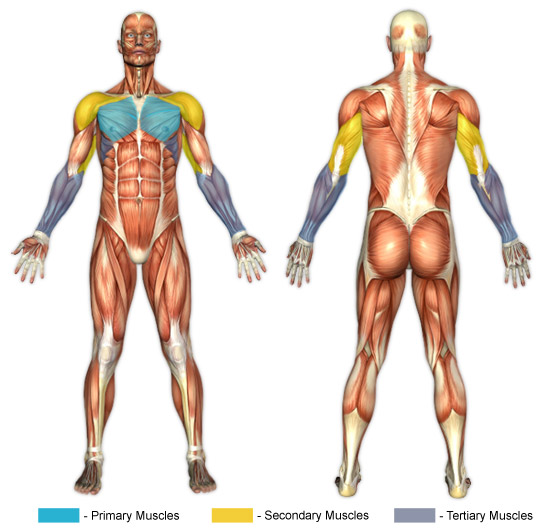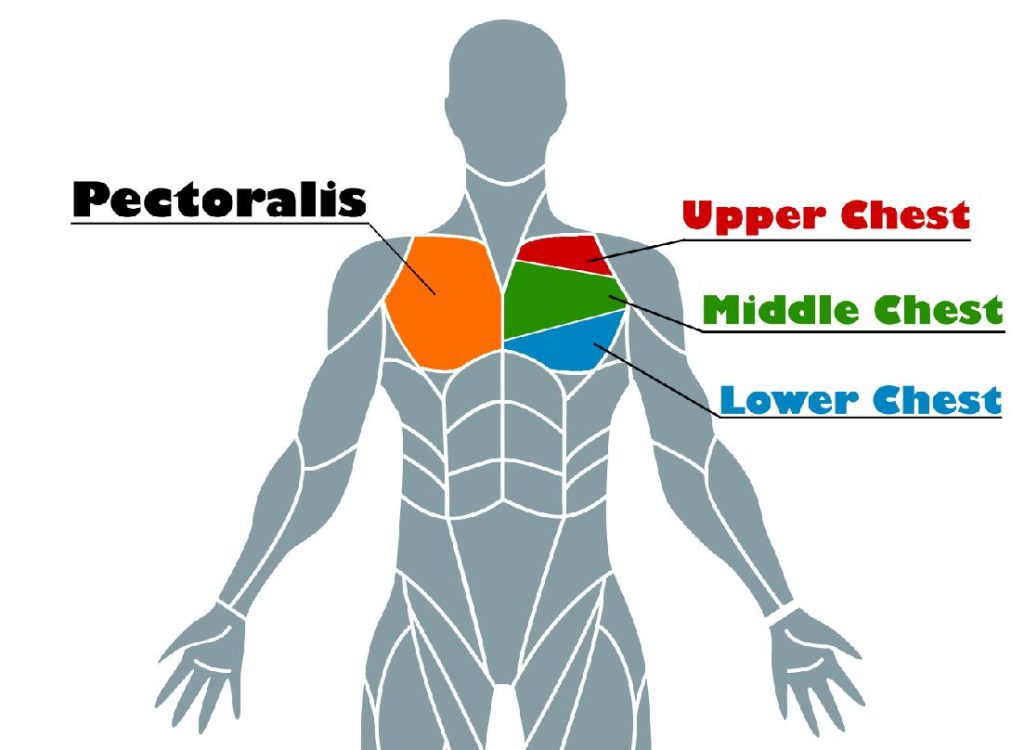What is the incline bench press?
The incline bench press is a resistance exercise that targets the pectoral muscles in the chest. It is a variation of the traditional, flat bench press and can be performed with either a barbell or a set of dumbbells.
Bodybuilders will often use an incline press to develop the upper section of the pectoral muscles to add mass and define the pectoral muscle.
Which muscles are worked with the incline bench press?
The target muscle for the incline bench press is the pectoral muscle in the chest. As it is a pressing movement, the anterior deltoid and tricep muscles are also activated as secondary muscles.
Your forearms will also play a minor role as stabilisers for your wrists.

It is possible to divide the pectoral muscle up into sections and target each part with different exercises. An incline press will typically hit the upper portion of the pectoral muscle.
By lowering the bench, you will be bringing the midsection into play and by declining the bench, the lower and midsection will be the main areas worked.

If you are a bodybuilder, you will need to vary your chest exercises to get a fuller chest and add definition between the pecs, shoulders and abs. Strength trainers can also increase their bench press numbers by regularly training different parts of the pectorals as accessory movements.
What angle should I use for an incline bench press?
There are a few different things to consider when trying to determine the best angle for an incline press.
First, you need to think about your own personal fitness goals. If you're trying to build muscle in the upper chest, a steep incline bench will assist with this. Aim for an angle of around 45 degrees. If you just want to add mass to the chest, set the bench at an angle of around 30 degrees.
Second, consider the amount of space you have available in your home gym or workout space. If you have limited space, a flat bench might be your best option.
Third, take into account any injuries or health conditions that might limit your range of motion. The most common reason for needing to use a steep angle is a rotator cuff or brachialis injury. Even after rehabilitation, mobility can be limited and a flat press can be very uncomfortable. If this is the case for you, focus on steep incline presses and chest dips.
Finally, listen to your body and don't be afraid to experiment until you find an angle that feels comfortable for you. the important thing is that you are using good form and can feel a good connection with the muscle.
In conclusion, the priority should be on a comfortable pressing movement and a good connection to the muscle. As long as the bench is between 30 degrees and 45 degrees, you will be fine. Anything less than this is pretty much a flat bench press and going steeper will take the pecs out of the equation and front delts will be doing the work.
How do I do an incline press?
The incline press is very similar to a standard bench press. You will need a dedicated incline bench or an adjustable bench set to incline position along with a barbell or dumbbells. If you are using an adjustable bench, set it to around 45 degrees.
Incline barbell bench press.
The standard way to perform an incline barbell press is with a barbell and dedicated incline bench. If you do not have a dedicated incline bench at your gym, you can wheel an adjustable dumbbell bench into the rack and set it to an incline position.
- Set up your bench to the desired incline, (ideally around 45 degrees) and add your plates to the bar.
- Lie on the bench. Make sure that your upper back is firmly pressed on the bench and arch your lower back up off of the bench. The feet should be apart and stabilising your stance.
- Grip the bar slightly wider than shoulder-width, lift from the rack and lower it to your upper chest. This is your starting position.
- Take a deep breath, upon exhale, press the bar directly upwards. At the top of the movement try not to lock out the arms and squeeze the pectoral muscles.
- Slowly lower the bar to the starting position. When it is an inch away from your chest, press the bar up again.
Tips for your incline bench press.
If lifting heavy, squeeze the bar with a tight grip before you lift it from the rack. this sends an irradiation signal to the rotator cuff in the shoulder and will give you extra stability in the press.
Use a powerful, explosive movement when pressing upwards, hold the weight at the top for a second or two before lowering it slowly. This will activate both the slow-twitch and fast-twitch fibres in the pectoral muscle which will, in turn, give you more growth.
Try to not lock out your arms at the top of the movement and do not allow the bar to rest on your chest at the bottom of the movement.
Keeping the muscle under constant tension will promote extra growth. You may not be able to perform as many reps with this method but the time under tension will yield better results.
Smith machine incline press.
The incline bench press can be performed with a smith machine if you have access to one. There are a few pros and cons to using a smith machine for this movement.
The main advantage is that you can train to failure without the need for a spotter. By using the safety blocks, you can push yourself for extra reps without the fear of dropping the weight on your chest.
By pushing yourself to absolute failure, you will be tearing down more fibres in the pectorals which will ultimately lead to more growth.
The main disadvantage is the rigid motion of the smith machine rails. You can only push the weight directly upwards and downwards with no flexibility.

To perform a smith machine incline press, wheel an adjustable bench into the smith machine, Sit on it with an empty bar and perform the press. Make sure that it is in a comfortable position and that the bar does not land too far down the chest or on the chin,
Incline Dumbbell bench press.
The press can be performed with dumbbells and target exactly the same portion of the pectoral muscle. The movement is essentially the same as a standard incline barbell press but using dumbbells allows for a larger range of motion.
By bringing the weights down to the side of your chest you can stretch the pectoral muscle. At the top of the movement, you can bring the weights together and really squeeze the pectoral muscle. This increased range of motion is great if you are training with lighter weights and a slow, controlled movement.
To perform an incline dumbbell press, set the bench up with an incline of around 45 degrees. Too much of an incline will take tension away from the chest and load the shoulder muscles.
Select your dumbbells, and sit on the bench with a firm grip on the dumbbell handles allowing the weights to rest on your knees. As you lie backwards, use your legs to flick the dumbbells into the starting position alongside your chest. From this position, it is just a standard pressing movement as detailed above.
It is important to make sure that you are using a sturdy bench and that your legs are spread apart so that your feet can provide a solid stance.
If you are training with heavy weights and taking your sets to failure, make sure that nobody is working out nearby and that you have no valuables on the floor such as a mobile phone. When training to failure without a spotter, there is no safe way to end the movement without dropping the weights to the side on the floor.
Some gyms don't allow this as they do not have suitable rubber flooring or rubber-coated dumbbells so be sure to check first.
Other ways of performing an incline press.
There are a few other methods of performing an incline press. You may be lucky enough to have an incline press machine in your gym.
Incline hammer press machines are a great way to develop your upper chest as they allow a smooth, steady movement making it easy to connect with the target muscle. The quick weight selector makes it great for pyramid sets or giant drop sets.
Another popular method is to use a twin cable machine. By wheeling an incline bench between two cables set to a low pulley, you can replicate an incline press movement with stirrups.
This method only really works on a twin cable machine that has the pulleys relatively close (1 metre or so). If you use cable pulleys that are much further apart, you will be essentially performing a fly movement instead of a press.


